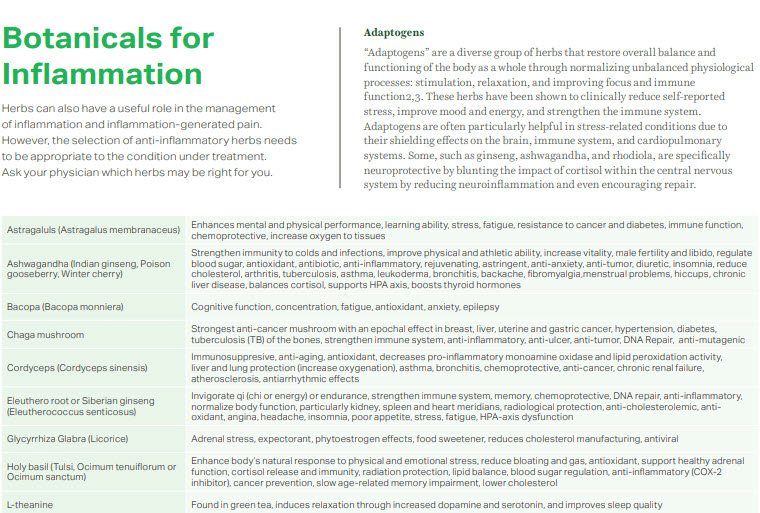 Bookmark
Bookmark Chronic Inflammation and Resolving Factors
Chronic Inflammation and Resolving Factors
Chronic inflammation is theorized to be at the root of many leading causes of disability and death, playing a role in conditions such as “cardiovascular disease, cancer, diabetes, chronic kidney disease, non-alcoholic fatty liver disease, and both autoimmune and neurodegenerative disorders.”1 Though inflammation is a normal and protective function of the immune system, unresolved inflammation will lead to tissue damage, scarring, deterioration, and – eventually – total loss of function.
Is Inflammation Good or Bad?
The goal of a healthy immune response is to isolate and limit damage caused by injury, invasion, or infection. It involves chemical signals that induce:
- Localized dilation of capillaries
- Recruitment of white blood cells to the target site
- Genetic transcription of enzymes and proteins
The normal inflammatory process is self-limiting, which results in repair, healing, and homeostasis. But if dysregulation occurs at any step of the cascade, inflammation can become chronic. The goal in maintaining a healthy response is not to block inflammation, but to balance pro-inflammatory processes with those that resolve it.
Specialized Pro-resolving Mediators and Inflammation
Previous models assumed that the resolution of inflammation was a passive process that occurred as chemical mediators dissolved and transcription factors abated.1 In the year 2000 however, the work of Charles Serhan, PhD, uncovered the very active process of resolution, controlled by specialized pro-resolving mediators, including maresins, resolvins, protectins, and lipoxins.2 These mediators are derived from polyunsaturated fatty acids (PUFAs). Maresins, resolvins, and protectins are synthesized from the omega-3 fatty acids eicosapentaenoic acid (EPA), docosahexaenoic acid (DHA), and docosapentaenoic acid (DPA); while lipoxins are derivatives of the omega-6 fatty acid arachidonic acid. A balanced intake of these PUFAs is important for proper function.
Omega-3 Fatty Acids & Inflammation
There are two essential fatty acids for humans: linoleic acid (an omega-6) and α-linolenic acid (an omega-3). These fatty acids cannot be synthesized internally, and are necessary building blocks for other important fats and chemical mediators. The Standard American Diet (SAD) is overabundant in omega-6 fatty acids, which are found in high quantities in packaged and processed convenience foods. Sources of omega-3 fatty acids such as fatty fish, seaweed, and certain seeds, are usually quite lacking in the SAD. This imbalance of fats can overwhelm the delta-6 desaturase enzyme responsible for elongating essential fatty acids into their initiating and resolving substances of inflammation, favoring those that are more inflammatory.
A 2017 literature review reported that omega-3 fatty acid supplementation results in an increase in levels of resolving factors in both experimental models and human trials.2 In addition, because the balance of fats is so important, it is interesting to note that omega-3 supplementation can improve levels of resolving factors without reducing levels of lipoxins derived from omega-6 fatty acids. The results from one randomized, double-blind, placebo-controlled clinical trial on Alzheimer’s patients compared supplementation with 1.7 grams of DHA and 0.6 grams of EPA with a placebo over a period of six months. The results showed increased levels of resolving factors with no change in the levels of lipoxin A4.2
Inflammation and the Microbiome
Prebiotics and probiotics are emerging as therapeutic modulators of resolution. Several preclinical studies have demonstrated that treatment with specific bacterial strains induces the activation of interleukin-10 (a pro-resolving cell signal) and is associated with a faster resolution of inflammation in models of allergy and Crohn’s disease.4 Though the mechanism of action awaits elucidation, there are emerging indications that dietary intervention with prebiotics and probiotics can promote the resolution of inflammation.
Herbs that Modulate the Inflammatory Response
Herbs can play a role in a healthy inflammatory response as well, even though their specific role in resolution is still unclear.
Turmeric, one of the most used spices worldwide, has been shown to act at various levels of the inflammatory cascade, downregulating transcription factors and cytokines while upregulating antioxidant defenses. Multiple clinical trials have shown a reduction in symptoms and biomarkers of inflammation associated with Crohn’s disease, ulcerative colitis, inflammatory bowel disease, postoperative inflammation, H. pylori infection and diabetes.3
Along with turmeric, components of boswellia, celery seed, ginger, garlic, onion, and sesame have shown activity in reducing the oxidative stress associated with inflammation, as well as downregulating inflammatory cytokine production and transcription factors.
Botanicals for Inflammation
Herbs can play a useful role in the management of inflammation and pain that often accompanies inflammation. However, the selection of anti-inflammatory herbs needs to be appropriate to the condition under treatment. Individuals are advised to ask their physician about what herbs.
Download: Download PDF
Novel Approaches to Managing the Inflammatory Response
The endocannabinoid system (ECS) is a biological signaling system with far-reaching physiological effects. One of the areas of influence is the immune system and inflammatory response. Though the body produces cannabinoids of its own called endocannabinoids (anandamide and 2-arachidonoylglycerol (2-AG)), there is a role to be played by the phytocannabinoids produced by plants.
The Cannabis sativa plant produces several components that act on the endocannabinoid system, either directly or indirectly. Cannabidiol (CBD), cannabinol (CBN), and the psychoactive fraction tetrahydrocannabinol (THC) are the most researched. Many studies have confirmed the ability of CBD to downregulate mediators of inflammation, while also reducing reactive oxygen species (ROS).6 But there is also data to indicate that CBD can increase levels of the anti-inflammatory endocannabinoid anandamide by downregulating fatty acid amide hydrolase (FAAH; an anandamide break-down enzyme).5
The science on resolving factors is emerging quickly, but the action of specific nutrients has yet to be fully studied and defined. Until that time, current dietary wisdom holds fast. Focusing on whole foods from a variety of sources and consuming sources of omega-3s and herbs will ensure an appropriate immune response and supply important substrates for the synthesis of resolving factors and, ultimately, the resolution of the inflammatory process.
References
- Furman, D., Campisi, J., Verdin, E. et al. (2019). Chronic inflammation in the etiology of disease across the life span. Nat Med25, 1822–1832. https://doi.org/10.1038/s41591-019-0675-0
- Serhan, C.N., et al. (2000). Novel functional sets of lipid-derived mediators with anti-inflammatory actions generated from omega-3 fatty acids via cyclooxygenase2-nonsteroidal anti-inflammatory drugs and transcellular processing. Exp. Med.192, 1197–1204.
- Norling, L.V., Ly, L., Dalli, J. (2017). Resolving inflammation by using nutrition therapy: roles for specialized proresolving mediators. Curr Opin Clin Nutr Metab Care, 20(2), 145–152. doi:10.1097/MCO.0000000000000353
- Gupta, S.C., Patchva, S., Aggarwal, B.B. (2013). Therapeutic roles of curcumin: lessons learned from clinical trials. AAPS J, 15(1), 195–218. doi:10.1208/s12248-012-9432-8
- LeVan, T.D., Romberger, D.J., Siahpush, M., et al. (2018). Relationship of systemic IL-10 levels with proinflammatory cytokine responsiveness and lung function in agriculture workers. Respir Res, 19(1), 166. doi:10.1186/s12931-018-0875-z.
- Zurier, R.B., & Burstein, S.H. (2016). Cannabinoids, inflammation and fibrosis. FASEB J, 30(11), 3682-3689. doi:1096/fj.201600646R
- Furman, D., Campisi, J., Verdin, E. et al. (2019). Chronic inflammation in the etiology of disease across the life span. Nat Med25, 1822–1832. https://doi.org/10.1038/s41591-019-0675-0
- Serhan, C.N., et al. (2000). Novel functional sets of lipid-derived mediators with anti-inflammatory actions generated from omega-3 fatty acids via cyclooxygenase2-nonsteroidal anti-inflammatory drugs and transcellular processing. Exp. Med.192, 1197–1204.
- Norling, L.V., Ly, L., Dalli, J. (2017). Resolving inflammation by using nutrition therapy: roles for specialized proresolving mediators. Curr Opin Clin Nutr Metab Care, 20(2), 145–152. doi:10.1097/MCO.0000000000000353
- Gupta, S.C., Patchva, S., Aggarwal, B.B. (2013). Therapeutic roles of curcumin: lessons learned from clinical trials. AAPS J, 15(1), 195–218. doi:10.1208/s12248-012-9432-8
- LeVan, T.D., Romberger, D.J., Siahpush, M., et al. (2018). Relationship of systemic IL-10 levels with proinflammatory cytokine responsiveness and lung function in agriculture workers. Respir Res, 19(1), 166. doi:10.1186/s12931-018-0875-z.
- Zurier, R.B., & Burstein, S.H. (2016). Cannabinoids, inflammation and fibrosis. FASEB J, 30(11), 3682-3689. doi:1096/fj.201600646R











